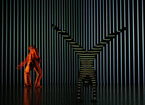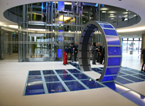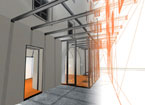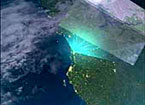| |
|
|
|
|
||
|
||||||||||||||||||||
|
|

I nteraction design as core competence manifests itself
in the lab-atelier’s activities via an approach to man-machine interaction that
stays focused on the process of mediation itself—in real space, in screen-based
media and in 3D space. The idea behind a human-computer interface is not conceived
of by taking its endpoints (device–user) as the starting point, but rather on
the basis of the aesthetic, content-driven and functional dramaturgies that
develop within the interaction. Thus, the technological solution is only a
secondary consideration in the design of interaction processes, since this
is primarily dictated by the demands that the contents place on the interaction.
By focusing on the intuitive interaction with content, the content and the medium
transporting it are assumed to be identical and the user interface is designed
correspondingly—in contrast to the way a computer is operated by means of
conventional input techniques. So, for one thing, the lab-atelier works out
interaction metaphors that are derivatives of human beings’ repertoire of
collective memory and accustomed modes of haptic interaction in the form of
design ideas for processes of exchange. On the other hand, the Futurelab also
creates interaction paradigms that, in correspondence to completely novel
manifestations, phenomena and depiction possibilities, are truly pioneering
efforts that have to be tested in a type of proving-ground setting first.T he Ars Electronica Futurelab’s specific approach
to the theory and practice of interaction design can be considered a
superstructure of all of the lab-atelier’s activities in the areas of Digital
Surfaces, Virtual Environments
and Interactive Spaces. At present, it is work in the fields of Media Art and Architecture, Exhibits, Media Performances and Information Design that make it clear how specialized typologies of projects develop from interaction design as the area of core competence. These various project types are indicative of the lab-atelier’s transdisciplinary approach; they are undergoing continuous development and new types are steadily being added to the mix. In addition to the current array of fully elaborated project typologies, there exists a series of additional focal-point projects in the field of interaction design including high-end 3D visualization and animation, industrial simulation and Web-based applications. 



Digital SurfacesT he development of strategies for mediating the encounter
with digital content is one of the key issues being raised by the prospect of
a digital future. "Digital Surfaces" are interfaces whose design can be the
key to success in disseminating content on monitor screens in the home, in
public spaces, in exhibitions, museums and educational institutions.
"Digital Surfaces" deal with new approaches to designing information flow
that go beyond the use of computer screen and mouse. Intelligent user interfaces
identify their environment, communicate with users and react to their behavior.
Users should be able to interact, communicate and acquire information in an
intuitive, natural and simple way. One approach to a solution proceeds from
the desirability of actively integrating user technologies that are commonly
subsumed under the headings "mixed reality" and "augmented reality."
Virtual EnvironmentsT he design and implementation of functional virtual
environments is based on two preconditions - the creation of suitable technical
infrastructure and the appropriate presentation of the content that is to be
featured. Often, one aspect or the other is determinative - that is, either
the content has to be adapted to the medium or the infrastructure has to be
expanded to accommodate what the material calls for. In order to live up to
these demands, the Ars Electronica Futurelab undertakes intensive research
in the fields of human-computer interfacing, visualization and interaction
in virtual space in an effort to create an ideal constellation customized
to each individual application. Products subsumed under the general heading
"Virtual Environments" range from architectural visualizations and industrial
simulations all the way to purely artistic and experimental projects.The aim of the Ars Electronica Futurelab's focus on "Virtual Environments" is to achieve a combination of graphic quality and intuitive user interaction. Rapid technological development-most of it triggered by the entertainment industry-has been generating an uninterrupted series of new opportunities and challenges in connection with visualization, 3-D graphics and animation. The evolution of virtual worlds has shown that content design assumes a role that is at least as significant as that of the technological preconditions, which have been following the same principles since the early days of VR. Interactive SpacesI nteractive Space focuses on the relationship of
interactive media to real space that can be physically experienced. The
use of digital media gives rise to new spaces and conceptions of space that
have an impact on the material space surrounding us. This gives rise to a
hybrid space in which virtual and real space blend together and reciprocally
influence each other. In context-sensitive and intelligent settings, the
physical delimitation of the space is eliminated via functional, experience-oriented
or artistic dramaturgies: the space’s architectural facts and circumstances
flow into the scenographic considerations; the space itself becomes an interface,
a transporter of information, a display. Interaction concepts that function on
the desktop/screen have to be reconceptualized for this space - above all
in response to the demands of the respective contextual conditions prevailing
in, for example, a public space, or the special requirements of an exhibition
dramaturgy. Moreover, considerations having to do with the “Internet of
things” and integrated systems for use on the job as well as for fun are
opening up new fields of activity: the creation of intelligent communications
networks linking up spaces, technologies and human beings, as well as the
development and evaluation of hardware interfaces.
|
| © Ars Electronica Linz GmbH, info@aec.at | ||||||||||